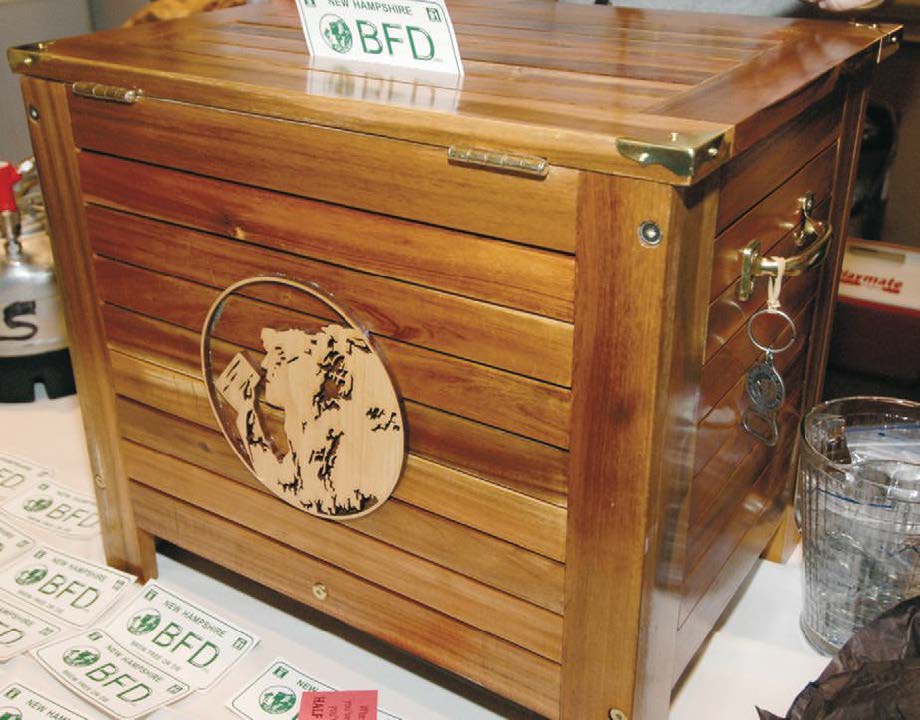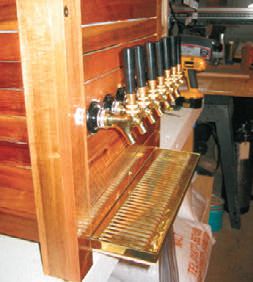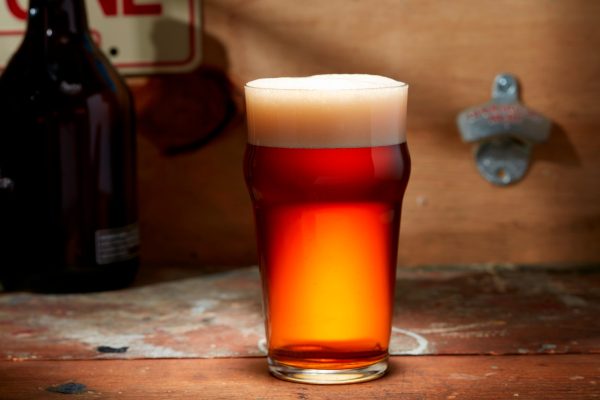
Originally published in the May/June 2009 issue of Zymurgy magazine.
A jockey box is a portable dispensing device used to chill beer just in time for serving, removing the need to keep kegs cold. A jockey box needs to be functional, easy to use, and ideally pleasant to look at as you are showcasing all the craftsmanship that went into making your homebrew.
It works on the principle that the kegs of beer are sitting at room temperature, and when the beer passes through the heat exchange (coil or cold plate) located in the cooler box, the beer temperature will drop to the ideal dispensing temperature. It is the perfect system for large parties or special events such as a family reunion, company picnic, camping, or Club Night at the National Homebrewers Conference. As it does not require any electricity, it can be set up anywhere. CO2 gas is used to pressurize the keg for dispensing.
Brew Free or Die will be serving its homebrew at this year’s National Homebrewers Conference, our third year of attending and serving beer at Club Night. In 2008 we took top honors by winning best beer at Club Night with a Zeus IPA from Todd Russell. The jockey box that I had previously built consisted of a five-way cold plate (capable of serving five beers at one time). It had worked great over the last several years, but I really wanted to increase the number of beers/meads/ciders that could be on draft.
I have had very consistent results with both types of heat exchangers (coils and cold plates), however I am not sure it’s practical to have seven coils inside one cooler. A cold plate consists of a cast aluminum block with stainless steel coils inside of it. I found a seven-way cold plate on eBay weighing in at 26 pounds.
I wanted a wooden exterior for the jockey box. Before heading to the hardware store to pick up the raw materials to build one from scratch, I took a quick tour of HomeGoods and found exactly what I needed. It’s an outdoor wooden cooler that’s meant to match the deck furniture. The price was about half that of anything I had found online. It was unfinished, designed to be taken apart with a hex wrench, and built to take the abuse of being outside for extended periods of time. All it needed was to be finished, and some other minor changes.
After getting the cooler home, I completely disassembled it so that I had five panels, which I proceeded to sand and polyurethane. Each layer of polyurethane must be allowed to dry completely (24 hours), then sanded with a minimum 200 grit paper, cleaned of dust and then a new layer of polyurethane applied.
I enhanced the structural integrity of the wooden exterior so that I could add handles to the side for easier jockeying around, and I wanted to ensure that the faucets would have enough support. Taking a 1/4” thick piece of plywood, I glued and secured the plywood to the slats on the sides where the handles were going, and the area where the faucets were going to be placed.
Since the hinges and connectors had brass finishes, I chose to keep all the accents in brass, including the drip tray, handles for carrying, and additional accent pieces.
Given that a jockey box is often sitting on a table, I didn’t want the inbound tubing exiting from the back of the jockey box, where it would be visible. So with the cool- er disassembled I drilled seven holes for the inbound beer lines, and then ran them down between the wooden exterior and the cooler. I connected the in- and out-lines so I could keep track of them for final assembly. I used 3/16” ID PVC tubing for the beer line, ordering 100 feet as it was more cost efficient. I used hose clamps on all fittings—there is nothing worse than opening a jockey box and seeing it full of your beer. The handles provide an easy way to carry the jockey box.

Next up was working out the logistics of where to place the faucets. I had a 17.5- inch surface to work with, allowing me to center the faucets every 2.5 inches, equally spaced. A 7/8” hole saw was used to cut the holes for the faucets. I was extremely worried about making a mistake at this stage, and measured twice to ensure I had accurate center marks before I drilled. Also of consideration is the height of the faucets.
I added a drip tray to the jockey box, and also built a drip tray slider that would allow me to hide the drip tray for storage and shipping, and allow for it to be extended without visible supports. I used two 5-inch sections of copper pipe and two 10-inch dowels. It’s set back 5 inches from the edge of the jockey box. A section of plywood is attached to the two dowels, and then I secured the support tray (oak board pictured) to the piece of plywood. Using a screw at the end of each dowel prevents the drip tray from being extended too far.
Michael Fairbrother is a lifetime member of the American Homebrewers Association and the treasurer of the Brew Free or Die homebrew club in New Hampshire.




Share Post